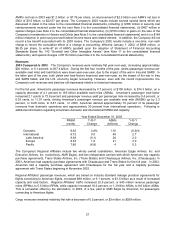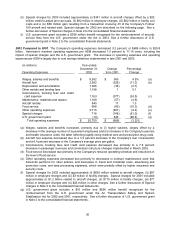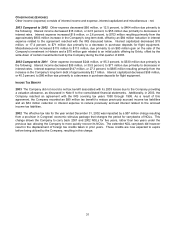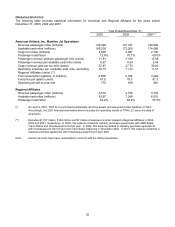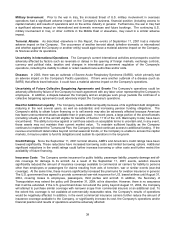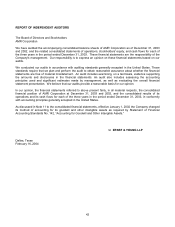American Airlines 2003 Annual Report Download - page 35
Download and view the complete annual report
Please find page 35 of the 2003 American Airlines annual report below. You can navigate through the pages in the report by either clicking on the pages listed below, or by using the keyword search tool below to find specific information within the annual report.
33
Government Assistance
In April 2003, the President signed the Act, which includes aviation-related assistance provisions. The Act
authorized payment of (i) $100 million to compensate air carriers for the direct costs associated with the
strengthening of flight deck doors and locks and (ii) $2.3 billion to reimburse air carriers for increased security
costs, which was distributed in proportion to the amounts each carrier had paid or collected in passenger security
and air carrier security fees to the Transportation Security Administration (the Security Fee Reimbursement). The
Company’s Security Fee Reimbursement was $358 million (net of payments to independent regional affiliates) and
was recorded as a reduction to operating expenses. In addition, the Act suspended the collection of the passenger
security fee from June 1, 2003 until September 30, 2003 and authorized the extension of war-risk insurance
through August 31, 2004 (and permits further extensions until December 31, 2004).
Outlook
Capacity for American’s mainline jet operations is expected to increase about six percent in 2004, despite
removing aircraft from the fleet and reducing mainline departures. This is due to increased efficiencies, driven by
three factors: (i) American operated with a low base number of flights in 2003 as a result of the war in Iraq and
SARS, (ii) American is adding seats back to its Boeing 757 and Airbus A300 aircraft and (iii) as American realigns
its mid-continent hubs and de-peaks its Miami schedule, its aircraft productivity levels will improve.
American’s goal is to improve its unit costs by 17 percent in the first quarter of 2004 compared to the first quarter
of 2003, and by ten percent for the full year, compared to 2003. American will have a full year of labor savings
from its Labor Agreements and Management Reductions and more fully realize the savings from its other strategic
cost savings initiatives. However, there are significant cost challenges in 2004 that may affect its ability to achieve
this goal, primarily from medical benefits costs, airport fees and maintenance, materials and repairs costs (due to
flight hour agreement contractual rate increases and the benefit from retiring aircraft subsiding). In addition, the
Company expects fuel prices to remain high during 2004. See “Risk Factors”.
Other Information
Environmental Matters Subsidiaries of AMR have been notified of potential liability with regard to several
environmental cleanup sites and certain airport locations. At sites where remedial litigation has commenced,
potential liability is joint and several. AMR's alleged volumetric contributions at all but one of these sites are
minimal compared to others. AMR does not expect these matters, individually or collectively, to have a material
impact on its results of operations, financial position or liquidity. Additional information is included in Part C of Item
1 and Note 4 to the consolidated financial statements.
Critical Accounting Policies and Estimates The preparation of the Company’s financial statements in
conformity with generally accepted accounting principles requires management to make estimates and
assumptions that affect the amounts reported in the consolidated financial statements and accompanying notes.
The Company believes its estimates and assumptions are reasonable; however, actual results and the timing of
the recognition of such amounts could differ from those estimates. The Company has identified the following
critical accounting policies and estimates used by management in the preparation of the Company’s financial
statements: accounting for long-lived assets, passenger revenue, frequent flyer program, pensions and other
postretirement benefits, and income taxes.






